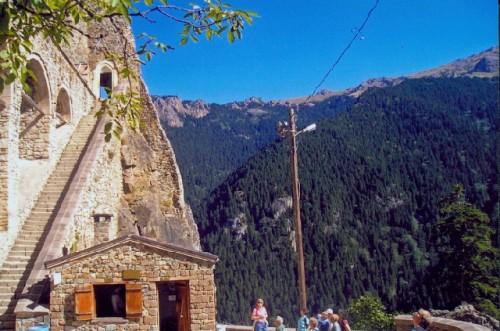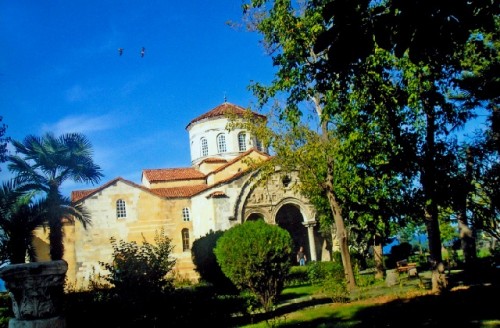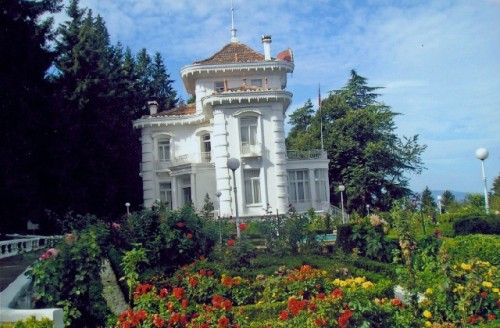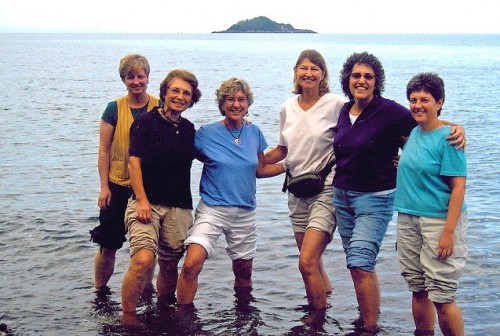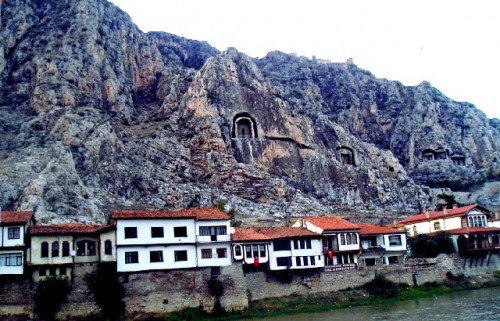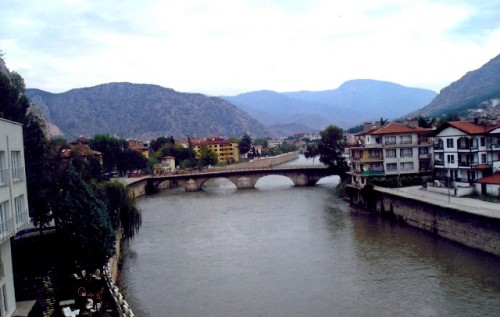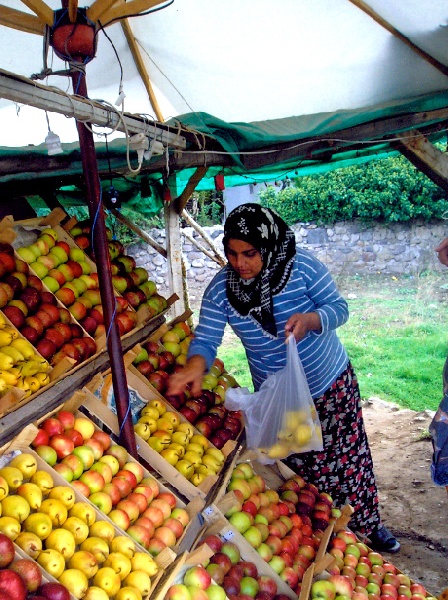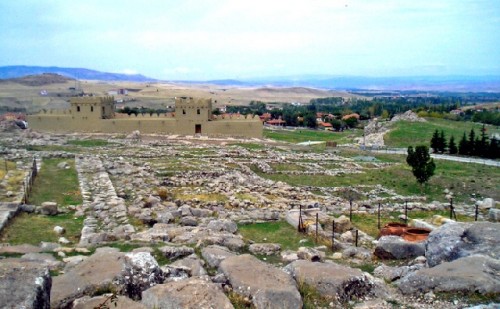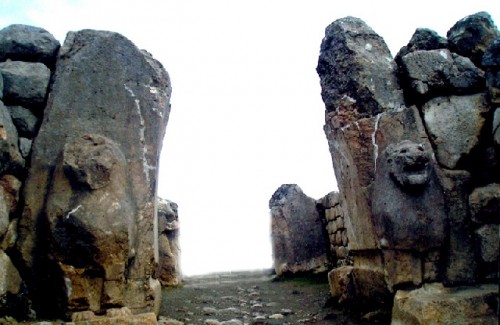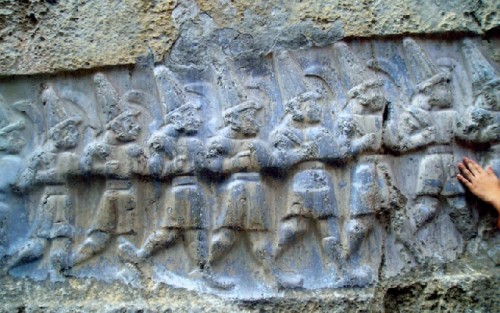Travel in Turkey Part Two
Trabzon and Amasya
By: Zeren Earls - Mar 14, 2007
Trabzon
A 7 a.m. flight took us from Istanbul to Trabzon. At the end of a 90-minute trip we landed in this coastal Black Sea town, once the seat of the Trebizond Empire founded in 1204 by Alexius Comnenus. It was clear and sunny, a perfect day to visit the Sumela Monastery up in the mountains, 54 km south of Trabzon. We drove through pine forests and hazelnut groves to reach the steep stairs of the monastery, set against the rocks and now situated within a national park. We viewed frescoes as we climbed up to the buildings against the sheer cliff, and admired the grand panorama down below.
Our lunch on the mountain featured local specialties such as black cabbage (collard) soup, stuffed black cabbage and a Turkish fondue called huymak, which is eaten with chunks of bread dipped in melted butter, cheese and cornmeal, followed by grilled trout. Descending from the mountain, we passed by fish farms and houses bunched around patches of arable land. People living in this rocky terrain are of Greek descent and still speak an ancient form of Greek because of their isolation.
There is a Haghia Sophia church in Trabzon, built after the one lost with the fall of Constantinople. Also later converted to a mosque, the church is now a museum set within a well-maintained garden near the coast. Finally at our hotel we called it a day as seagulls hovered overhead, and people rushing home for iftar deserted the streets.
Our second day in the city began with a visit to the Trabzon Museum, a restored mansion of a former Russian merchant. The upper floor features the ethnology of the region, the lower one its archeology with objects from various Roman, Byzantine and Ottoman digs. The garden, restored to its original state along with the mansion, is filled with dahlias, roses and date palms.
Atatürk's house is the former summer home of a Greek banker on a hill reached by a winding road. Surrounded by roses, the bust of the founder of the Republic sits on a base engraved with a proverb: "A nation's inspiration and strength come from its soul, not from its riches". Given to Atatürk as a gift by the municipality, this dwelling is where he wrote his will, leaving all he owned to the Turkish treasury. Among his memorabilia are letters telling how free he felt and how much more he wished to leave to the nation.
We continued on to the mountain resort Uzun Göl (Long Lake) for lunch. We passed by tea plants on terraced hills. The best yield of the low-lying plants is the shoots and the top two layers of the leaves. Once these are harvested they go to the factory for processing. The time of the harvest determines the color of the leaves, which range from green to black. Hazelnut trees also like the warm, humid climate of the Black Sea region, and grow densely on its steep hills. Harvesters with baskets on their backs tie themselves to the trees. Turkey is the largest exporter of hazelnuts in the world.
At lunch we enjoyed specialties such as red lentil soup, Ezo Gelin (Bride Ezo's soup) and stir-fried lamb with mountain thyme. The unique breadbaskets at the table caught my attention. Upon my inquiry as to where I could buy such a basket, the proprietor presented me with one as a gift. Since we were at this mountain resort off-season, the shops were closed. However, the owner of one was fetched for us. I was able to buy a square of the hand-woven cotton cloth that is typical of the region, with its alternating black and red stripes arranged from thick to thin on a white background.
Upon returning to the city a few of us rushed to Kemer Alti, the old bazaar, as shops tend to close early during Ramadan. Some were already pulling their shutters down. We passed by the gold shops and stopped to see the local fabrics. I was glad to find a similar piece to the one I had purchased earlier – this one a large rectangle, the perfect size for a tablecloth.
In the morning our bus headed west, following the rocky coastline with occasional fishermen's coves. Piers constructed of big boulders jutted out into the sea. We passed by women with bags tied to their waists collecting tea leaves with special scissors. Hazelnuts in their green outer shells spread out to dry filled patches of flat land. Cornhusks tied together formed miniature teepees. We stopped by the roadside to stock up on the region's produce and to wet our feet in the Black Sea. We returned to the bus with bags of tea, roasted hazelnuts and jars of hazelnut butter. The highlight of the roadside lunch was the carrot cake, served on the house. Made with semolina, carrots, sugar, hazelnuts and cinnamon, it was topped with ice cream.
After Istanbul the Black Sea coast is the most populated region of Turkey, where towns almost run into one another. The country's boat-building, coal, tobacco and rice industries are all in these coastal towns. We turned southward near Samsun and followed the inland road to Amasya. The landscape changed from lush green hills to flat fertile land with cows grazing. Sacks of onions waiting to be transported dotted the fields.
Amasya
A picture book city, Amasya sits astride the Yesilirmak (the River Iris) in the mountainous region that borders the Black Sea. It was the capital, Amaseia, of the Pontus Kings during Greek and Roman times. A citadel and Pontic cave tombs on the hill, along with old houses overhanging the river, all contribute to the city's charm.
At the Amasya Museum, the upstairs, dedicated to the Ottoman ethnology of the region, displays a woman weaver at the loom, textiles and embroidered bridal dresses, recalling the city's fame for its silk manufacturing. The street level has archeological artifacts, including mummies brushed with a preservative that has kept the whole bodies intact, unlike the Egyptian ones, from which eyes and other organs are removed. Roman marble columns fill the garden.
The Gök Medrese/Mosque (1266) is a typical Seljuk building with carved stonework and tiles depicting angular geometric patterns. The Sultan Bayezit II Mosque (1486), built by the son of Mehmet, the conqueror of Istanbul, still has an active soup kitchen, which had a long line of people waiting to get into the green-tented area nearby to end their fast.
The Amasya Hotel, where we stayed, is strategically located facing the river. I spent the evening with Connie and her daughter Margaret on the balcony playing backgammon on their newly acquired inlaid set. I was sound asleep when cannons announcing sahur (the predawn meal) woke me up. The best time for sahur is the last half-hour before dawn, after which fasting begins again until sunset. I had just gone back to sleep when roosters began crowing as if they knew we had a long journey ahead.
Breakfast featured a local specialty, keskek, made with chickpeas, wheat and meat. Other offerings on the buffet included Amasya's famous sweet crisp apples, tahini halva, yogurt, honey, feta cheese, olives, tomatoes, cucumbers and variety of breads. On the way out of town we stopped by a roadside stand stacked with apples and pears and stocked up for our trip to the heartland, the Anatolian central plateau.
On the bus Evin, our guide, gave us a short history lesson. During World War I Mustafa Kemal, then a general in the Ottoman army, met with representatives of Anatolian town leaders in Amasya, where they promised to give all they could to fight the allied forces on the occupied fronts, basically covering all the shores: Russia in the north; the British, Australian and New Zealand armies in Gallipoli, to protect entry into Istanbul from the Dardanelles; the Greeks in the west; Italy in the south; and France in the southeast. The longest battle (three years) was with the Greeks, who dreamed of reestablishing the ancient Greek Empire in Anatolia. In 1922 the Greeks were driven out of Anatolia; the rest of the occupying forces withdrew and accepted Turkish victory.
Mustafa Kemal, now given the name "Atatürk" (father of the Turks), abolished the Sultanate, established the Parliament and founded the Republic in 1923. He abolished the caliphate in 1924 and began a series of reforms: Swiss civil law replaced Islamic sharia, Western-style dress brought greater equality in appearance to all, school reform introduced compulsory education, the Latin alphabet replaced the Ottoman script, and women became entitled to vote and eligible to serve in Parliament. All the reforms became law within the 15 years of Atatürk's presidency.
Among the roadside billboards advertising consumer goods, one paid tribute to history: "There is no nation without those who have died in war." As we continued southward on the excellent road, I was reminded of a very bumpy ride over muddy ruts across the same terrain in 1964. The transformation of the central plateau was amazing, not only in its roads, but also in the giant industries that had cropped up everywhere: Fiat, VW and Toyota car dealerships, grain, nut and dry fruit factories, sugar plants and chicken farms alternated with vast fields of wheat. Tractors had replaced oxcarts. Much to my delight, strong infrastructure was in place; the visible poverty of the heartland was no more.
A stopover in Hattusas (currently Bogazkale), the capital of the Hittite Empire on a hill, took us back to 1200 BC. The Hittites were an Indo-European people whose kingdom, at its height, stretched from the Aegean Sea to east of the Euphrates and included much of Lebanon and northern Syria. Cuneiform inscriptions on tablets found in the late 19th century reveal the power and importance of this kingdom. Towers and temple gates, houses and fortifications punctuate the ruins. The Lion's Gate has two protective stone lions. The relief of a war god distinguishes the King's Gate. According to new findings, an underground tunnel represents a passage to the underworld.
Two kilometers away is Yazilhkaya (meaning "Inscribed Rock"), the sanctuary of the Hittite Empire built around a natural rock cleft. An open-air gallery of stone reliefs depicts in detail the beliefs of the worshipers and the rituals they performed to please the gods. Gods and goddesses in stone relief process toward a central spot. The village boys of Bogazkale make a living carving marble replicas of the ancient reliefs and statues. I bought a lion statue from a young boy, who impressed me with his chunk of marble from a nearby quarry carved into a shiny lion baring his teeth. It makes an attractive bookend.
We continued our journey through the 1000-meter-high plateau. Erciyes, an old volcanic mountain and the third highest in Turkey, gradually emerged. The region's distinctive fattailed sheep, wheat and sugar beet fields, and vineyards completed the scenery.

